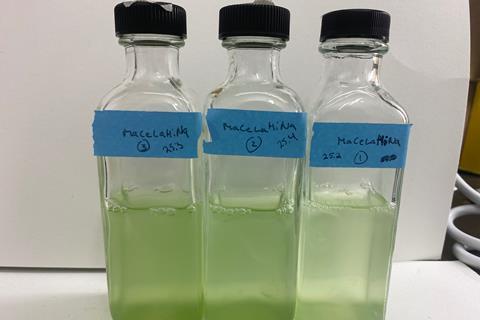A new study delves into how the age and size of microplastics affects the growth of harmful algal blooms.

Scientists at the University of Wisconsin-Madison carried out the research, which recently appeared in Sustainable Microbiology, an Applied Microbiology International publication, and is entitled ’Microplastic Characteristics Differentially Influence Cyanobacterial Harmful Algal Bloom Microbial Community Membership, Growth and Toxin Production’.
READ MORE: Grazing zooplankton severely impacted by nanoplastic particles - but cyanobacteria unaffected
READ MORE: Lessons learned from microbes that stick to plastic
Microplastics are a problem of increasing concern to the public and in particular to aquatic systems where they tend to accumulate. Similarly, cyanobacterial harmful algal blooms (cHABs) have been observed to occur more frequently in these same water bodies.
Interactions and aquatic health
This study aimed to identify what the interactions between these two things were, and determine what their co-occurrence could mean for the health of these aquatic systems in terms of the severity of these algal blooms, according to corresponding author Dr. Erica Majumder.
“Since runoff which contains the nutrients that facilitate these blooms often carry microplastics as well, we studied the interactions between the cyanobacteria that cause these blooms and these microplastics. More importantly, we did this with a wide variety of microplastics with different characteristics, since this is more environmentally relevant than using standard plastic beads/particles,” she said.
The team cultured two different types of cHAB microbial communities, one containing the planktonic, toxin-producing Microcystis aeruginosa and the other containing the filamentous, non-toxin producing Trichormus variabilis, obtained from blooms in Lake Erie with microplastics of varying physicochemical parameters, and specifically altering polymer type, size, concentration, and UV-ageing time to mimic plastics encountered in the environment.
Polymer characteristics
They used a statistical analysis tool called Design of Experiments to determine the specific conditions used in each of the experiments, allowing them to generate a model to determine how specific polymer characteristics influenced the cyanobacteria.
“Over the course of four weeks, we measured growth rate within each of these 40+ culture conditions, and the toxin content within our cultures containing M. aeruginosa. We found that while we did see differences in growth rate and toxin production for M. aeruginosa in the presence of plastics, these changes were not significantly driven by specific microplastic properties, but more so by the presence of plastics in general (decreased growth, increased toxin production),” Dr. Majumder said.

“For T. variabilis however, we did see significant variation in growth with specific polymer characteristics, most notably with decreases in growth rates as size of polymers increased. Additionally, the response of T. variabilis growth rate changed with the UV-aging of these fibers, indicating that UV-aged fibers reduced growth compared to non-aged fibers.
Sink or float
“Consistently throughout these trials, we noticed that T. variabilis, which commonly settles to the bottom of the culture container without MPs, but was suspended along the surface of the cultures and draped down with some MPs.
“This happened both with plastics which floated on their own, but also with our cellulosic plastics, which were more dense than our culture media. We noticed gas bubbles trapping the cellulosic plastics on the surface, and T. variabilis suspended from those.“
As plastics continue to accumulate in aquatic environments, we need to be conscious of and study the ways in which they will interact with existing phenomena, like cHABs, Dr Majumder said.
Future threat
“This study aimed to characterize these interactions because we believe that these types of interactions will be more and more commonplace in the future, and if we are able to gain an understanding of these interactions now, we can be better prepared to address challenges that may arise from them in the future.
“Laboratory settings aren’t the best at capturing how these interactions may occur in the environment, and we are actively working towards conducting these experiments in more environmentally relevant ways, specifically looking at how motion in lake systems might influence these interactions further.
“We are also interested in building upon our research into the microbial community membership attached to these plastic particles. The Plastisphere is a growing field of study, and in seeing how T. variabilis attached to these plastics, we want to build towards a better understanding of what this attachment means for the fate and transport of plastics and any microbes attached to them.”
A new approach
PhD candidate Fuad Shatara led the experiments and modeling, supported by the co-authors. Azul Kothari was an undergraduate researcher at the time. Dr. Liyuan Hou wrote most of the original grant when she was a postdoctoral fellow and helped Fuad get the experiments started. Dr. Erica Majumder and Dr. Kiyoko Yokota provided mentoring and experimental and analysis guidance throughout.
“Kiyoko even jumped in the lake to teach us how to set up certain experiments! The collaboration between different expertise on this project really helped it come together and allowed us to approach these questions in a new way,” Erica added.
Funding came from the Great Lakes Research Consortium and we obtained the cultures and advice from the lab of Greg Boyer at SUNY ESF.
’Microplastic Characteristics Differentially Influence Cyanobacterial Harmful Algal Bloom Microbial Community Membership, Growth and Toxin Production’ is published in Sustainable Microbiology.
Topics
- Algae
- Applied Microbiology International
- Azul Kothari
- Clean Water
- Community
- Early Career Research
- Environmental Microbiology
- Erica Majumder
- Fuad Shatara
- Greg Boyer
- harmful algal blooms
- Healthy Land
- Kiyoko Yokota
- Liyuan Hou
- Microcystis aeruginosa
- microplastics
- Plastic degradation
- plastisphere
- Research News
- Sustainable Microbiology
- Trichormus variabilis
- University of Wisconsin-Madison
- USA & Canada







No comments yet